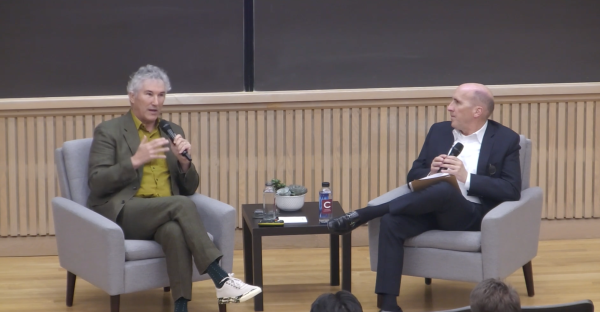A Weaponless War on Terror
Professor of English and Art History at the University of Chicago W.J.T. Mitchell delivered a lecture Tuesday on a “war of images” that has arisen from the War on Terror. He focused on an image of an anonymous, hooded Abu Ghraib prison detainee standing on a cardboard box with his arms outstretched. The lecture, co-sponsored by the Peace and Conflict Studies and the Film and Media Studies departments, was titled “Cloning Terror: the War of Images from 9/11 to Abu Ghraib.” “We live in a world where images are weapons of war,” Mitchell said, “Sometimes victims of war.” Mitchell combined the text of a chapter from his upcoming book, State of the Union, or Jesus Comes to Abu Ghraib, with a PowerPoint slide show of images and video clips. He showed pictures that would be among the first found by a Google image search for “terrorist,” and then for “clone.” The first showed several armed men wearing hoods, the second, an army of masked, armed clones from Star Wars II: Attack of the Clones. Clones and terrorists evoke the same ideas in the mind of mainstream Americans, he said: anonymity, loss of identity, invisibility and facelessness. He cited the cloning-like redoubling of terrorism since the beginning of the War on Terror and described cloning as the new science fiction horror: “aliens that we’ve created out of ourselves.” Mitchell then described why, of all of the photographs to emerge from the Abu Ghraib abuse investigation, this hooded prisoner became the most well-known. He called it the “logo” of the ordeal. “When this image appeared in April 2004 … there was a kind of unconscious recognition,” Mitchell said. First, he said, the picture of the hooded man is more modest and less chaotic than many others. The subject is not naked, filthy, dead, on his knees, in a tangle of bodies or in an obvious stress position; he is standing still and facing the camera. Mitchell referenced Meyer Schapiro’s concept of a “theme of state”: a picture that indicates an “I” facing a “you.” The photograph has the visual appeal of symmetry, contrasting colors and absolute stillness.Second, and more complicated, the hooded man’s posture hearkens back to Jesus’ crucifixion, one of the most familiar figures in Western society. Even stories and images that precede that of Jesus involve a single figure facing the viewer with arms outstretched: Hittite gods, Moses at the Battle of the Amalekites and those in attitudes of prayer. In addition, representations of Henry II and Hobbes’ Leviathan have taken this posture. The downward slant of the hooded man’s arms may call to the viewer’s mind different images of Christ, however, such as the Man of Sorrows, depictions of blessings and miracles and the Harrowing of Hell. “It’s surely improbable to suggest that it’s meant to recall Christ,” Mitchell said, cautioning his audience to “stop looking at it as a logo for a moment and try to project yourself into the situation depicted.” However, Mitchell reminded the audience that Jesus was a political prisoner and was raised up and mocked, much as the guards at Abu Ghraib literally raised up (on a cardboard box) and mocked the hooded man. “This photograph, to put it crudely, was paid for with your tax dollars, our and mine,” Mitchell said. “We own it and we must own up to what it tells us about ourselves.” Mitchell also drew parallels to photographs that white Americans used to take of themselves grinning at lynchings of African Americans. He showed what various groups have done with the image of the hooded man, highlighting a silkscreen by Forkscrew Graphics of the figure silhouetted against a bright pink background with the wires colored white and the word “iRaq” pictured next to a silhouette of a hand grenade, meant to parody Apple’s iPod advertisements. “It is very much like a corporate logo,” Mitchell said. “It awaits filling with content.”Mitchell was well received by faculty, who believed that he presented an important perspective for students. “[Mitchell is] one of the most astute interpreters of the relationship between the media and politics, and I think it was important for Colgate students to hear this,” George W. and Myra T. Cooley Professor of Peace Studies and Professor of Art & Art History Dan Monk said afterward.




